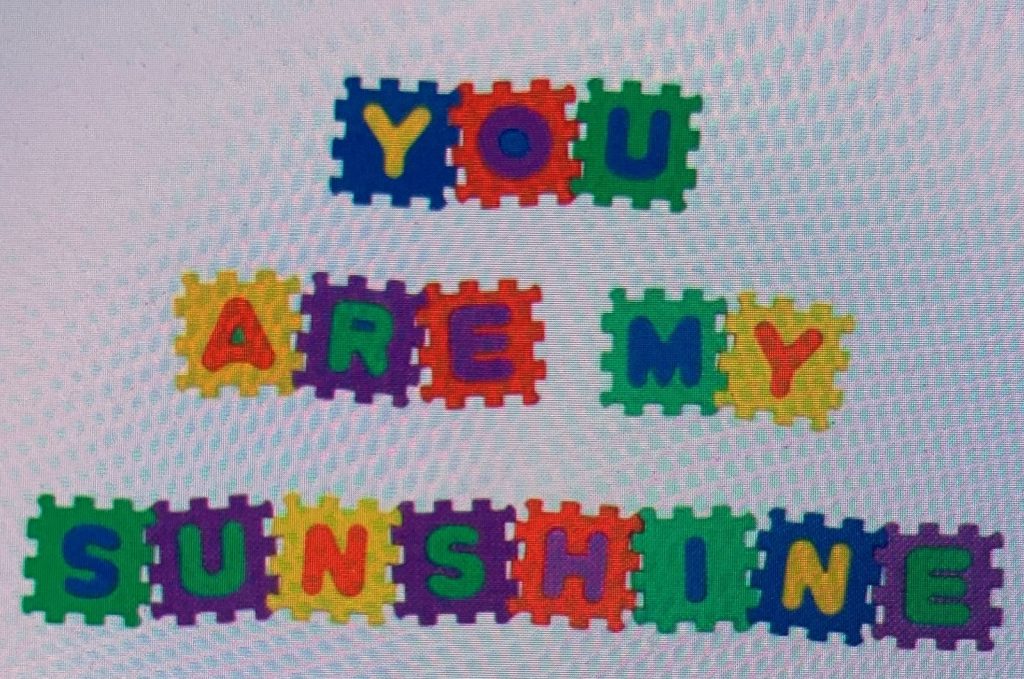Anya and Aruna are busy watching a film in their room and are too smitten by the beautiful princess gracefully waltzing away to the soft, romantic sounds of the ballroom music that they do not pay any heed to the repeated calling out of their names by their mother from the kitchen. Angry and frustrated at the girls for not caring to respond to her calls, the mother marches like a toy soldier across the living room into their room and angrily quips “You girls are as deaf as door posts! Can’t you even respond when you hear me calling out your names? What do you think I am – an engine huffing, puffing & whistling all day long?” Unfazed by their mother’s indignation, the girls retort dreamily, “Mother! Cinderella dances like a dream! and she looks as pretty as a rose. She is so fresh like a daisy and her skin looks like lucid dew drops! Her hair blows like a gentle breeze as if carrying with it the sweet fragrance of jasmines that adorn her crown” The mother is taken aback by how unaffected they both are to her severe reprimand. They seem to be completely lost in their own world. To add to her mother’s bewilderment, they both sigh in resigned unison, “Aww! How I wish I was her carbon copy!
How interesting is the above depiction of a typical mother-child/children scenario that has played out innumerably in all our lives at some point or the other. If one notices, the finer details of the situation are effectively brought about by the metaphors (that have been highlighted). These metaphors effectively bring out the contrasting moods of the mother and the children without creating any kind of confusion and lending a very entertaining, comic touch to the situation making it an enjoyable passage to read.
As one reads the passage, the angst of the mother, the mesmerised state of the girls and the beauty of Cinderella – all create powerful visual images in our mind. The metaphors also lend an auditory modality when it describes the music as being soft and romantic and even a kinaesthetic touch with the description of waltzing gracefully, gentle breeze – as if we are can feel these elements.
Metaphors as Linguistic Devices
-
Metaphors are descriptive analogies (comparisons) in the parts of a speech.
-
They add details to specific aspects of any kind of communication – spoken or written, by providing the receiver (reader/ listener) with more clarity and depth of understanding.
-
Metaphors can be in the form of words or phrases.
-
They explain the fact of the matter by likening it to another attribute (person, place or thing) by means of a comparison.
-
The use of Metaphors symbolically explains any situation by stressing on its extent of its effect. For example: – happy as a lark, drowning in misery, box like situation, etc.
-
Usually, there are technical linguistic differences between Similes and Metaphors, but the take away from them both is the use of analogy in expression of a particular thought, word, deed, person, situation.
Metaphors teleport the reader to the exact place and scenario, exponentially increasing the effects particular thoughts, feelings, behaviours – that could be both positively or negatively reinforcing.
Metaphors in Therapy
Metaphors are important tools of expression in therapy. These tools come in handy when the clients are not able to exactly define their present issues at hand and also help in conveying the magnitude/extent of those issues.
For example:
1. A client who feels confused about his/ her sense of direction or the next step in the current scenario of his life can choose to say that “I feel as if I am lost/ stuck in a maze/ labyrinth.”
2. Another client was told me,” I feel stressed and exhausted at my inabilities to deal with my life and feel like pressing a reset button
We can see from the above examples, that Metaphors facilitate the transmission of the information from the client to the therapist and gives a sense of understanding to the therapist about what the client is currently experiencing and in what direction and magnitude is it progressing.
Metaphors are figures of speech that may not be literally applicable but bring out a deeper meaning to what needs to be conveyed and expressed. Reality defined by Metaphors, depending on the choice of metaphors adopted, carry with it a unique sense of perspective from individual to individual.
Hence, it will be fair to say, that Metaphors fill in the blanks of expressing a particular thought or emotion when one is unable to effectively convey the exactitude of what he/ she is experiencing in literal and realistic terminology.
 KINDS OF METAPHORS
KINDS OF METAPHORS
The real world is perceived literally and is stored, recalled and conveyed figuratively through metaphors.
Metaphors can be broadly classified into two categories, based on the purpose of their usage.
DIAGNOSTIC METAPHORS & THERAPEUTIC METAPHORS
DIAGNOSTIC METAPHORS: As the name suggests, Diagnostic Metaphors diagnose the current scenario or presenting problem of the client by the expressions of thought, word, emotion, with the Therapist, facilitating an appropriate solution. The diagnosis is the interpretation of what is encountered/ unearthed during the course of the administration of the Diagnostic Metaphor.
Examples of Diagnostic Metaphors :- Abstract Metaphor/ Drawing Analysis, Body Syndromes, Graphology/ Handwriting Analysis, Tarot Cards, Angel Cards, Dream Analysis, Projective Psychological tests like: – Rorschach Ink Blot Test, Thematic Apperception Test, Sentence Completion Test, Word Association Test, Freudian Slip and many more.
Therapeutic Metaphors are those figurative thoughts, words, actions or situations that strive to create a sustainable change in the current situation of the client leading it to its desired objective. Due to these Metaphors being largely associated with conscious change, they are also referred to as CHANGE METAPHORS. Examples of Therapeutic/Change Metaphors:- Metaphorical Stories like fables, religious/ mythological take aways, Idyllic Metaphors that consist of pleasant, pristine, happy, nature-oriented surroundings that give positivity and relaxation to the client, Control Metaphors that help in adjusting the magnitude of their wanted /unwanted elements in their life in terms of visual, auditory, kinaesthetic modalities.
 Metaphors like Introspection Metaphors, Revelation Metaphors, Reframe Metaphors, Transformational Metaphors are used both for Diagnostic as well as Therapeutic purposes.
Metaphors like Introspection Metaphors, Revelation Metaphors, Reframe Metaphors, Transformational Metaphors are used both for Diagnostic as well as Therapeutic purposes.
CLIENT GENERATED METAPHORS & THERAPIST GENERATED METAPHORS
Metaphors that are initiated, controlled and interpreted by the Client, are called CLIENT GENERATED METAPHORS. These are usually generated by the client, in the form of a response to a question, asked by the Therapist.
For example: Therapist – “How do you feel?”
Client – “I feel trapped as if I am in a dark room”
And this metaphor of the client being trapped in a dark room is further explored by the client himself, by means of objective driven suggestions provided by the therapist. In this manner, the client slowly but surely finds ways and means to wriggle out of the trapped situation by self- initiating prospective solutions.
Metaphors that are initiated, directed and steered by the therapist keeping the best interest of the client in mind are called THERAPIST GENERATED METAPHORS.
For example: Therapist (after knowing that the client is religiously inclined) takes the example of the famous Mahabharata scene where the entire GEETA GYAN is professed by Lord Krishna and steers the client to gain meaningful take aways that could have a significant connection with his/her current situation. Depending on how the client receives this suggestion, this metaphor is further explored by the therapist keeping the best possible interest and bent of mind of the client. Eventually, it is the client only who decides for or against the motion and the therapist is nothing but a mere catalyst to the change.
A GLOSSARY OF METAPHORS WITH EXAMPLES:
-
Visual Metaphors like:
-
standing atop a mountain feeling triumph
-
walking alongside the sea shore with the sea waves washing away all the agony and pain that is releasing from the body
-
imagining a white light enveloping the body serving as a protective shield
-
releasing a balloon into the sky that carries within it all that is unpleasant and unwanted
2. Auditory Metaphors like:-
Listening to the echo of one’s voice/ another’s voice taking the message it sends
-
Feeling good and positive by increasing the knob of the music that is being heard in the background.
-
Plugging one’s ears/ turning down the volume to avoid hearing an undesired sound
-
Being consciously receptive to a message that could be giving an answer to one’s problem.
-
Listening to the silence and noticing what it does in the heart and the mind
3. Kinaesthetic Metaphors like:
-
Taking out a pocket air gun to shoot the undesired, troubling element far away out of sight
-
Experiencing a wave of relaxation entering the body from the extremities and moving into each and every part of the body.
-
Standing under a waterfall to wash off any kind of unpleasant emotion that one may be carrying on the outside surface of the body
-
Mending a broken or incomplete sculpture, painting, etc.
-
Writing a message on a piece of paper and seeing the hand move in constant motion till it finishes.
To conclude, one must remember, that Metaphorical Associations are always initiated, generated, conducted and experienced in a state of deep relaxation or imagination because it is a process of using one’s subconscious faculties and tools in decoding the deepest and most real of abstract expressions that seek to represent an account closest to the concrete reality.
Metaphors are indeed well-crafted implements of diagnosis and change used in Psychotherapy, that enable the clients address their perceptions symbolically and seek guidance and solution by bringing about a change in those very perceptions by using a better and corrected version of the metaphor or juxtapose another metaphor that they identify with to bring in the desired change.What better way to understand Metaphors than through a child’s world based on the rhyme
You are my Sunshine My only Sunshine You make me Happy
-
When skies are Grey
You’ll never know dear How much I love you
Please don’t take my Sunshine away!








